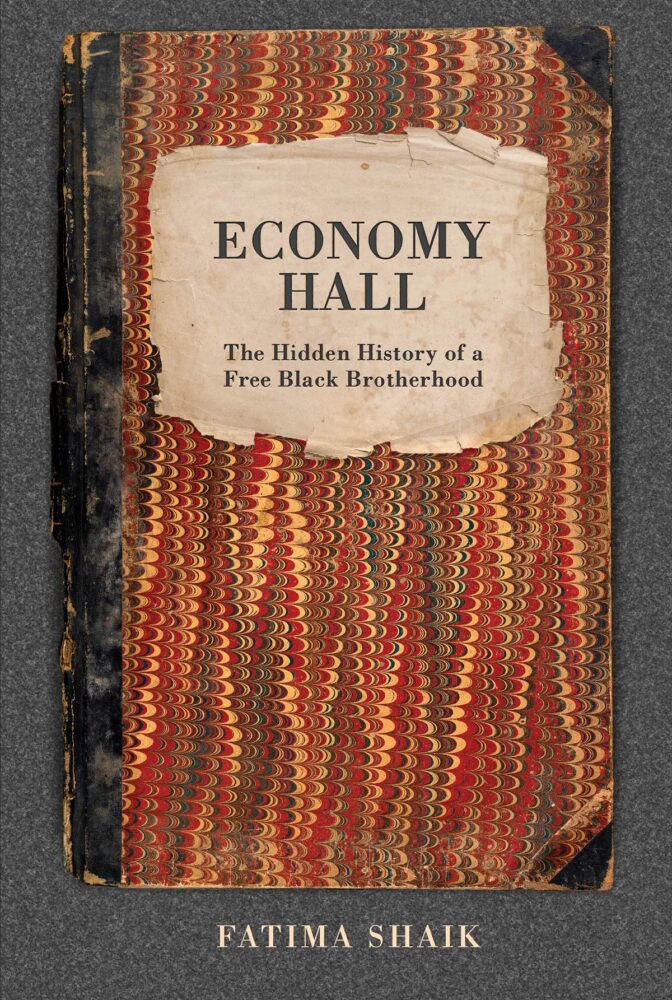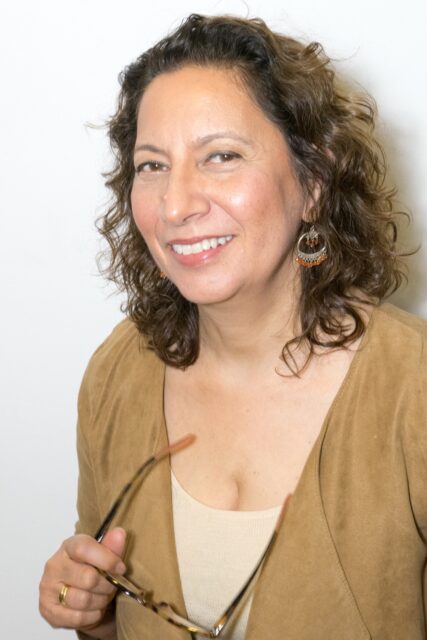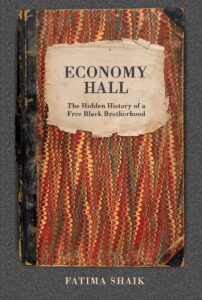Fatima Shaik’s Economy Hall Named the 2022 LEH Humanities Book of the Year
The Hidden History of a Free Black Brotherhood
Published: February 28, 2022
Last Updated: June 9, 2023

The Historic New Orleans Collection
<NOTE> Economy Hall: The Hidden History of a Free Black Brotherhood by Fatima Shaik is the 2022 LEH Humanities Book of the Year. In Economy Hall, Shaik chronicles the story of a community that fought for the rights of all men—regardless of skin tone or previous condition of servitude—to claim the privileges of American citizenship. Tracing the history of a complicated, multiracial New Orleans through the voice of Ludger Boguille, an educator, organizer, and member of the Société d’Economie et d’Assistance Mutuelle, Shaik’s deeply researched storytelling challenges long-dominant narratives and creates new understandings of our shared past.
One evening in the 1950s, my father rescued a small library of rare books from the back of a pickup truck. Among them were twenty-four handwritten ledgers, some with marbleized paper covers and spines that were two inches wide. The oldest books had thick, ochre-colored pages made of rag paper. The later ones contained smooth, blue-lined stock. Crammed between thin margins was French script as elegant as a satin-stitched monogram on a linen handkerchief.From their weight, their tough leather bindings, and my parents’ warnings to avoid touching the books, I knew they were important. But they were significant at the time only to us. After all, they had been tossed into the trash.
They were, I later learned, the handwritten records of the Economy Hall from 1836 to 1935. The old wooden building is now known worldwide as one of jazz’s most famous incubators. But few people knew its history in my childhood. Segregation further prevented its story from reaching the mainstream.
The hall’s elderly owners were members of the Société d’Economie et d’Assistance Mutuelle (the Economy and Mutual Aid Association). The benevolent organization was disbanding because it had become obsolete. Twentieth-century Black-owned insurance companies and funeral homes took over the society’s nineteenth-century functions of providing practical and financial support for families during illnesses and deaths. Economie member Louis Wilderson Sr. was responsible for selling the hall’s contents, collecting the proceeds, and distributing them. He was my father’s best friend.
The armoires, desks, chairs, and other furniture were sold off, but nobody wanted the ledgers and library books. So Mr. Wilderson sent them to the garbage dump. Having second thoughts, he told my dad, who hurried that evening to the nearby home of the trash hauler. The books remained in the bed of a pickup, where a rainstorm had drenched them. Some were destroyed. My father retrieved as many books as he could, brought them home in his car, and spread them across our front porch to dry. They promised to be good primary sources for his research.
My dad was in his late thirties then and full of intellectual ambitions, yet he feared that he had reached the zenith of his career. As a boys’ counselor at George Washington Carver public school, he modeled professionalism—wearing suits, white shirts, and ties, sometimes in ninety-degree heat. But he was palpably frustrated. He could not go into archives, libraries, restaurants, and other public venues because they barred people then designated as Colored or Negro. The strain frequently sharpened the contours of his face.
Nevertheless, he independently advanced his education. He invited any number of people he met to our home for dinner and conversation in which they exchanged knowledge. He created a library in our house with purchased or found texts like the Economie books.
My dad also listened to Mr. Wilderson’s suggestion to take the summers to study, certainly outside of the South, preferably outside of the country. So, in 1957, Mohamed Shaik—a brown-skinned man with a name inherited from his Indian father, and the great-grandson of an enslaved woman—enrolled at the University of Ottawa. Over the next six summers, he drove our family along one- and two-lane highways for four grueling days each way between New Orleans and Canada, where he earned a PhD.
My mother was Lily LaSalle, a native of St. Martinville, Louisiana. French was her first language. In Canada she was able to dip into a cool well of memory as she spoke daily with locals. She also escaped New Orleans’s physical and emotional heat. Another benefit of the more than 1,500-mile journey was our relief, for a short time, from the daily scrutiny of the South and one of its consequences—relentless anxiety for people of African descent.
I didn’t know the reason that French meant so much to my father. I later realized that his urban community inherited the language and maintained it by choice.
It was around that time that my father rescued the ledgers of the society. He called it “the Economie,” using the French pronunciation—“ay-co-no-MEE”—never its English version, Economy. I often heard thoughts expressed in two parlances. But I didn’t know the reason that French meant so much to my father. I later realized that his urban community inherited the language and maintained it by choice.
Our neighborhood was the Seventh Ward, a city district drawn in 1852. Living there were many descendants of Louisiana’s French speakers. They were also the progeny of the Spanish, Africans, Native Americans, and other people of color who had maneuvered through segregation’s maze of regulations and atmosphere of discouragement by becoming doctors, dentists, teachers, and skilled tradesmen. Many of these people also had free colored ancestors—men and women who were not enslaved.
In the first decade of the nineteenth century, two out of three residents of New Orleans were colored. They were already an established community when the Louisiana Purchase occurred in 1803. For the next forty years, almost half of these people were free. Along with the enslaved, these free
colored families built and occupied the wood and brick houses of the city. Their children and grandchildren participated in the flowering of the city, which by the 1840s became one of the biggest and most important urban centers in the United States. Their descendants still lived in New Orleans more than a hundred years later.
During my childhood in the 1950s, this community resided primarily in the Seventh Ward and called themselves Creole to remind everyone of their history. The term referred to all people who traced their roots to the earliest New World families—colonial Spanish, French, and West Africans and, often, hybrids of them all.
Others in the city, however, claimed European ancestry without any trace of mixed blood. They, too, were descendants of the city’s early settlers. They also called themselves Creole. But during some past decades, they had qualified that designation, using “white Creoles” or “French Creoles” to separate themselves from people with roots in Africa. Or they simply called us “natives” and “Negroes.”
The battle for the use of the term Creole had become pitched in the late nineteenth and early twentieth centuries, when white supremacy reigned. Purity was critical. As The Picayune’s Guide to New Orleans explained in 1903 when it discussed hybrid Louisiana, “Everything ‘that is good’ in New
Orleans is ‘Creole.’” The booklet explained that the natural environment of Louisiana had created strains of produce and livestock that local buyers and sellers prized, and they identified these varieties by the term Creole. The guide went on, however, to exclude people of mixed races: “One hears, too, the term, ‘Creole negroes,’ but it must be remembered always that this is a fine distinction, meaning the Blacks and colored people that are Louisiana bred and born and French-speaking as distinguished from the
negroes of other States. ‘Creole’ means white.”
The requisite purity caused southern white historians and writers to extract people of color from books or to ignore them, except for popular stereotypes. From the mid-1850s pamphlets of New Orleans–based Dr. Samuel A. Cartwright, who lectured on racial superiority as a scientific fact, to Margaret Mitchell’s Gone With the Wind in 1936, to any number of books of fiction and nonfiction until the 1960s, light- and dark-skinned clichés were the norm—quadroon seductresses and tragic mulattos, mammies and bucks. But the facts, especially in Louisiana, showed a range of skin colors, occupations, and economic conditions among African descendants. Nonwhites appeared abundantly in city and state records, though these documents lay fallow. In general, white historians did not concern themselves with the fates of Africans, and the primary sources held in most archives were inaccessible to Blacks. As a result, the published history of New Orleans was always incomplete.
Meanwhile, my community actively maintained a fortress of stories. I grew up learning history on porch steps, in corner groceries, during baptism breakfasts, and especially at the dinner table. At some point in every gathering, family members and friends would bring up their disappeared and deceased relatives, then launch into their history. Each spoke of the past with the passion of a man wrongfully accused of a crime who repeats over and over his account of the moment that proves his innocence. People from our community said their families were once rich, participated in government, fought in the Battle of New Orleans, and appealed to President Abraham Lincoln for their rights. Ancestors had owned houses and land, traveled to Haiti and France, and lived in Mexico, my relatives claimed. The Creoles were the offspring of white men who loved them, as much as Negro children could be loved in the South, people said. (They did not add that Creoles were also the products of rape.) I nodded and smiled, but I was a skeptic. I thought my family was just trying to give me hope because almost everything I read said that all Negroes were slaves and anyone who mixed with them was inferior.
In 1966 my cousin Elizabeth Moore created an after-school Black empowerment group at Saint Mary’s Dominican High School. She was its first president. I held the post the next year. We sought authors to inform us and found James Baldwin, Eldridge Cleaver, Ralph Ellison, W. E. B. Du Bois, and others. But about New Orleans, I could uncover only fiction by Alice Dunbar-Nelson, biography by Charles Barthelemy Roussève, and a poetry book by my mother and her friends, Arrows of Gold. They offered scant support for the stories of our elders. All this time, the historical proof resided in the Economie journals stacked in a cabinet in my family home. The books had traveled only fourteen blocks
from the Economie’s meeting hall in the Tremé neighborhood. A wealth of unrealized knowledge filled their untouched pages.
By college I was still searching for an explanation of the racial conditions that had formed and still affected me. I attended Xavier University of Louisiana for two years, then transferred to Boston University to study journalism. After graduation, in 1974, I reported for the Miami News and the New Orleans Times-Picayune. I left again in 1976 for graduate school at New York University and to work as a writer. Over the next two decades, I wrote articles for national and international publications. I also
wrote four books of fiction that allowed me to delve into memory and history—a collection of novellas called The Mayor of New Orleans: Just Talking Jazz, two picture books titled The Jazz of Our Street and On Mardi Gras Day, and Melitte, a young adult novel in the voice of an enslaved girl in eighteenth-century Louisiana.
All that time, the journals stayed on my mind. I remembered their size (about as big as my childhood suitcases) and heft (dense as the St. Joseph bricks for the sidewalk that my grandfather laid into the mud) and the way that my father had carried the books into the house, blotted the rainwater from their pages and covers, wrapped them in newspaper and Schwegmann grocery bags, and placed them in the red lacquered cabinets he built next to the bricked-up fireplace, across from the photos of his and my mother’s parents and grandparents.
My father had received his PhD in 1964 with a dissertation about the education of Negro children in Louisiana. He went on to head the division of education at Xavier University of Louisiana and, later, the division of aeronautics at Delgado Community College—where he had been refused an interview during segregation. He had grown older and more content, and he had left the Economie books alone.
One day in 1997, during a visit home to New Orleans, I looked in the cabinet. Nothing had changed since I was a child. The journals still sat on the shelf. I pulled out the books and arranged them in chronological order on the dining table. I opened the first volume and saw the date, January 1836. By then I knew something of American history as well as Black history, and the ways they had diverged. I realized that not only were these books old, but they told a story about America that few people alive had heard.

